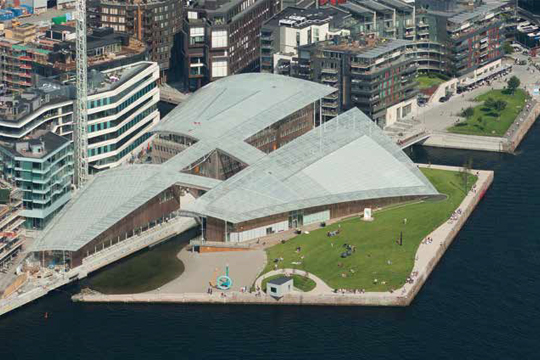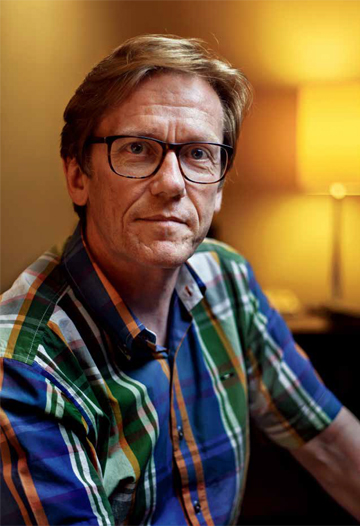GUNNAR B. KVARAN
DIRECTOR OF ASTRUP FEARNLEY MUSEUM OF MODERN ART
Dr. Gunnar B. Kvaran is the Director of the Astrup Fearnley Museet of Modern Art in Oslo, and the curator of the Biennale de Lyon 2013. In his concept for the biennial, Kvaran also reveals himself to be a radical conductor of narrative who believes “the originality of a story’s artistic gesture stems from the originality of its narrative constructions.” While Kvaran was conducting here in China, LEAP sat down with him to discuss his vision for Lyon.
LEAP Could you tell us about the Astrup Fearnley Museet?
Gunnar B. Kvaran The museum is private, which is quite special in Scandinavia, because most museums of contemporary life in general are state-driven. Only about 10% of our collection is Norwegian art. The national gallery and many of the regional museums take care of Norwegian art, and we feel we are complementary to that fact. Besides us, there still haven’t been other institutions in Norway that have the capacity for or perhaps even interest in collecting contemporary international art.
LEAP In other words, you as a private museum shoulder lots of responsibility, affecting people, their lifestyles, their way of thinking and mentality.
GBK Absolutely. This is very interesting because Norway is one of the most socialist countries in the world. The state owns most of the basic industry: the oil industry, the fishing industry, and for some time, the media too. Very early in the century, they had adopted a very radical socialist attitude. And then in the last 10-15 years, the capitalist system has influenced, of course, the whole world. Capitalism has become universal; even you have this in China. Now in Norway there is an interesting balance between the private and state-driven companies.
At a certain point the people in Norway and even Scandinavia began to doubt having only one “truth” in terms of media and even in terms of museums. In Europe, people thought, in fact, it’s very important to have different voices to tell different stories. We began with private radio stations, and then private TV stations, which today we think is totally normal—also to have a private museum as a part of this kind of polyphonic voices of different opinions.
LEAP You will have noticed that Chinese private museums are growing in recent years. Considering the social context, what kind of suggestions would you like to offer them?
GBK I think today it is very important to have this two-sided approach, the national and the international. And I think it is very important for these institutions in China to be able to accommodate both international artists and the local scene at the same time. It is important to create contact between the international and local art scenes, to show the knowledge and production to the public. To be able to contextualize the local art scene.
I’d like to know more about museums here. The museum model in Europe, especially in northern Europe, is based on openness to the world. Society is protective, we have our identity, our social democracy—which is good in terms of healthcare and schools—but at the same time we are open to what’s happening on the outside. That’s why in our museum in Oslo we have a collection of Chinese contemporary art—it is not for the Chinese, but for our people, our society, and our children to have knowledge about what the art scene in China has produced. The museum, no matter whether public or private, should have such a role and task.
LEAP What about your concept for the Biennale de Lyon?
GBK I want to explore narrative art within international contemporary art. I want to especially look at how young artists are questioning and reinventing new narrative structures, how narratives are formalized. It is like literature—you want to write a love story, but there are many ways of formalizing the story. With contemporary art, you have a lot of different topics within the artworks. It can be fiction, it can be autobiography, it can be political, it can be social, it can be a reflection on the notion of art, it can be purely aesthetic… but there’s always the fact that all these artworks that are dealing with narratives and storytelling in visual art have to find a way to visualize their narratives. This is really the topic of the biennial.
Of course, historically, the art scene is about narrative art. My challenge was to make a selection, and to make a special narrative structure for the exhibition. It should not be a historical exhibition. I should permit myself to speak in the first person, and to make a purely subjective selection. Instead of dealing with the history of art, I would like to deal with the history of art within my own history.
When I consider the role of the curator, I am mostly preoccupied with two things: knowledge production (producing something new), and clarity of concept and intention. These have to exist in and of themselves. It is not just about creating a constellation of works or artists. It is about the exhibition as meaning, and about the concept that unites the selected artworks. I think with many of the exhibitions you’ve seen all over the world in the last 10-15 years, alongside the inflation of curators, it is more about the exhibition production than about knowledge production.
LEAP Can you offer a definition for this narrative format?
GBK Narratives bring out the possibilities of knowledge and emotions, but the originality of the world is very much in the formal aspect. You can have a love story, but how you formalize it is, in fact, the important part. The strength of creating emotion lies in its formal or aesthetic aspect. Then, of course, there is the content, the meaning of the work. Alain Robbe-Grillet and Roland Barthes really emphasize the fact that it is not only about the content—it’s also about how you give shape to the content.
LEAP Hence the title “Meanwhile… Suddenly and Then.” A nod to story- telling.
GBK I thought it would be important to have a title that did not explain the content, nor be too narrative in and of itself, but a trigger for the storytelling. At the beginning I thought that “Narratives” was quite a good title for the exhibition but later found out that it was too content-focused. And then I had this title called “The World is Made of the Story”—a beautiful title, but too nice, too welcoming, and also forgetful of the formal aspect. It was only about me telling the stories, but the biennial is not about that. It is about how stories are being told.
Contemporary art in the last 30 years has been very much about appropriation—again, think of Roland Barthes and the death of the author. Everything has been said, written, and created. The only thing we can do now is to adopt existing forms and figures and show them from different angles. It is now about the images and reality, the notion of art—is it art? This is, philosophically, a very interesting reflection about the notion of contemporary art. But of course, many works within the appropriation of art are not really that interesting. But there are some great artists like Richard Prince with his cowboys, or Jeff Koons, who appropriates what he thinks of as the aesthetics of the American middle class. He also appropriated the porn industry, and eventually created a real setting, a vision of the porn industry as part of a middle-class phantasm. And then it’s Cindy Sherman and how she represents the cliché and image of the American middle-class ladies, but often seen through the eyes of Surrealism. It is not about appropriating images, but about appropriating the ideas of clichés about the pre-conceived role of women in American society. These artists were mostly dealing with images, but in recent years, we have seen artists who are showing more interest in storytelling– artists like Matthew Barney, Fabrice Hyber, and Paul Chan– who are also preoccupied with creating new aesthetics and narrative structures.



















